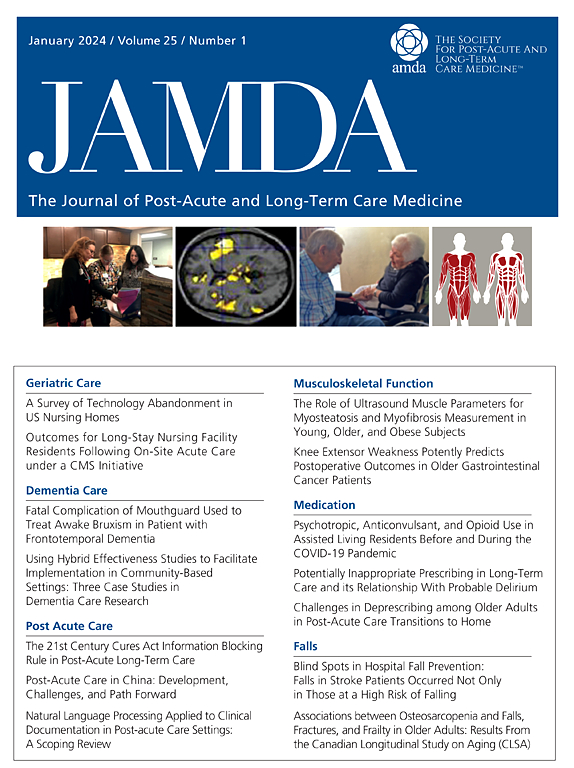长期护理所有权和经营者因素在可能的谵妄:来自加拿大安大略省的一项基于人群的研究
IF 4.2
2区 医学
Q2 GERIATRICS & GERONTOLOGY
Journal of the American Medical Directors Association
Pub Date : 2025-05-12
DOI:10.1016/j.jamda.2025.105610
引用次数: 0
摘要
目的评价长期护理(LTC)房屋所有权模式与经营者特征与可能谵妄患病率之间的关系。设计采用省级卫生行政数据进行横断面研究。背景和参与者所有年龄在65-105岁的加拿大安大略省LTC居民,在2016年1月1日至2019年12月31日期间通过居民评估工具-最小数据集2.0版本进行评估。方法采用住院医师评估工具谵妄临床评估方案-最小数据集2.0版评估,确定可能的谵妄。使用多变量logistic回归模型评估LTC房屋所有权模型(营利、非营利和市政)和经营者特征(连锁状态、经营者规模和房屋大小)与可能的谵妄的关系。结果在本研究纳入的169,762名LTC居民中,94,014人(55.4%)居住在营利性住宅中,42,051人(24.8%)居住在非营利住宅中,33,697人(19.8%)居住在市政住宅中。仅有3.6% (n = 6182)可能出现谵妄。与非营利性家庭相比,营利性家庭和市政家庭可能出现谵妄的调整优势比(aOR)分别为0.83 (95% CI, 0.66-1.06)和0.89 (95% CI, 0.64-1.25)。住在大房子里的居民可能出现谵妄的几率较低(aOR, 0.49;50-99张床位的95% CI为0.33-0.72;100-149张、≥150张vs≥50张的aOR为0.68,95% CI为0.47-0.99)。调整后的可能谵妄的几率没有因连锁状态或经营者规模而异。结论和意义:在床位≥50张的家庭中,sltc患者发生谵妄的几率降低。这一发现可能反映了不同房屋所有权模式在谵妄风险或识别方面的差异。没有证据表明,谵妄的患病率在LTC房屋所有权模式、运营商规模或连锁状态之间存在差异。本文章由计算机程序翻译,如有差异,请以英文原文为准。
Long-Term Care Ownership and Operator Factors in Probable Delirium: A Population-Based Study from Ontario, Canada
Objectives
To evaluate the association between long-term care (LTC) home ownership models and operator characteristics and the prevalence of probable delirium.
Design
Cross-sectional study using provincial health administrative data.
Setting and Participants
All LTC residents aged 65–105 years in Ontario, Canada, who underwent assessment via the Resident Assessment Instrument—Minimum Data Set, version 2.0, between January 1, 2016, and December 31, 2019.
Methods
Probable delirium was identified using the delirium Clinical Assessment Protocol on the Resident Assessment Instrument—Minimum Data Set, version 2.0, assessment. LTC home ownership model (for-profit, not-for-profit, and municipal) and operator characteristics (chain status, operator size, and home size) were evaluated in relation to probable delirium using multivariable logistic regression models.
Results
Among the 169,762 LTC residents included in this study, 94,014 (55.4%) lived in for-profit homes, 42,051 (24.8%) in not-for-profit homes, and 33,697 (19.8%) in municipal homes. Only 3.6% (n = 6182) had probable delirium. The adjusted odds ratios (aOR) of probable delirium in for-profit and municipal homes were 0.83 (95% CI, 0.66–1.06) and 0.89 (95% CI, 0.64–1.25), respectively, compared with not-for-profit homes. Residents in larger homes had a reduced odds of probable delirium (aOR, 0.49; 95% CI, 0.33–0.72 for 50–99 beds; aOR, 0.68, 95% CI, 0.47–0.99 for 100–149 beds, ≥150 beds vs <50 beds). The adjusted odds of probable delirium did not differ across chain status or operator size.
Conclusions and Implications
LTC residents in homes with ≥50 beds had reduced odds of probable delirium. This finding may reflect differences in delirium risk or identification across home ownership models. There was no evidence that the prevalence of probable delirium varied across LTC home ownership models, operator size, or chain status.
求助全文
通过发布文献求助,成功后即可免费获取论文全文。
去求助
来源期刊
CiteScore
11.10
自引率
6.60%
发文量
472
审稿时长
44 days
期刊介绍:
JAMDA, the official journal of AMDA - The Society for Post-Acute and Long-Term Care Medicine, is a leading peer-reviewed publication that offers practical information and research geared towards healthcare professionals in the post-acute and long-term care fields. It is also a valuable resource for policy-makers, organizational leaders, educators, and advocates.
The journal provides essential information for various healthcare professionals such as medical directors, attending physicians, nurses, consultant pharmacists, geriatric psychiatrists, nurse practitioners, physician assistants, physical and occupational therapists, social workers, and others involved in providing, overseeing, and promoting quality

 求助内容:
求助内容: 应助结果提醒方式:
应助结果提醒方式:


